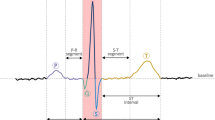Abstract
In the present work, statistical processing of the electric cardiogram (spectral and bispectral analysis) using the ‘sliding window’ method is proposed and performed. A system for recording and digitizing an electric cardiograms was developed, the output signal of which is fed to a computer. Signal processing is carried out using a system implemented in the LabVIEW environment. It is shown that the time-frequency analysis using the ‘sliding window’ method allows detecting dynamic processes in the work of the human heart, which can go unnoticed in standard analyzes. Research results can be useful for the diagnosis of heart disease.




Similar content being viewed by others
REFERENCES
McCraty, R., Exploring the Role of the Heart in Human Performance, Vol. 2, HeartMath Research Center, 2015, p. 118.
Kuznetsov, A.A., Biofizika Serdtsa (Biophysics of the Heart), Vladimir: VlGU, 2012, p. 237.
Waller, A.D., The Journal of physiology, 1887, vol. 8, no. 5, p. 229.
Burch, G.E. and DePasquale, N.P., A history of electrocardiography, Norman Publishing, 1990.
Berkaya. S.K. et al., Biomedical Signal Processing and Control, 2018, vol. 43, p. 216.
Sornmo, L. and Laguna, P., Electrocardiogram (ECG) Signal Processing, Wiley Encyclopedia of Biomedical Engineering, 2006.
Chua, C.K., Chandran, V., Acharya, R., and Min, L.C., Medical Engineering and Physics, 2010, vol. 32, no. 7, p. 679.
Wang, J., Wang, P., and Wang, S., Biomedical Signal Processing and Control, 2020, vol. 55, p. 1.
Ghista, D.N., et al., Journal of Medical Systems, 2010, vol. 34, p. 445.
Moeyersons, J., Smets, E., Morales, J., et al., Computer Methods and Programs in Biomedicine, 2019, vol. 182, p. 105050.
Istepanian, R.S.H., Hadjileontiadis, L.J., and Panas, S.M., IEEE Transactions on Information Technology in Biomedicine, 2001, vol. 5, no. 2, p. 108.
Zelensky, A.A., Kravchenko, V.F., Pavlikov, V.V., and Totsky, A.V., Fizicheskiye osnovy priborostroyeniya (Physical foundations of instrumentation), 2013, vol. 2, no. 3, p. 4 [in Russian].
Petropulu, A.P., Higher-Order Spectral Analysis, CRC Press LLC, 2000.
Chang, J.H. and Lee, W.S., Journal of Information Science, 2005, vol. 31, p. 76.
Totsky, A.V., Systemy obrobky ynformatsyy (Information Processing Systems), 2009, vol. 3, p. 108 [in Ukrainen].
Author information
Authors and Affiliations
Corresponding author
Ethics declarations
The authors declare no conflict of interest.
Additional information
Translated by V.M. Aroutiounian
About this article
Cite this article
Oganisyan, B.A., Oganesyan, T.N. & Makaryan, A.O. Time-Frequency Analysis of Electric Cardiograms. J. Contemp. Phys. 55, 371–375 (2020). https://doi.org/10.3103/S1068337220040155
Received:
Revised:
Accepted:
Published:
Issue Date:
DOI: https://doi.org/10.3103/S1068337220040155




